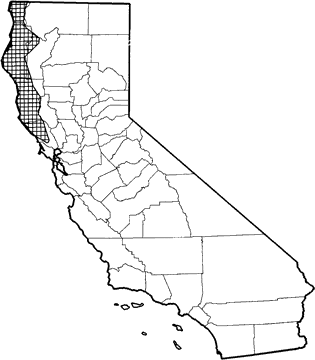
California Red Tree Vole
Distribution, Abundance, and Seasonality
Distributed along the North Coast from Sonoma Co. north to the Oregon border, being more or less restricted to the fog belt. Reported to be rare to uncommon throughout its range, but the difficulty of locating nests and capturing individuals makes abundance hard to assess. Occurs in old-growth and other forests, mainly Douglas-fir, redwood, and montane hardwood-conifer habitats.

Range Map
Specific Habitat Requirements
Feeding: Specializes on needles of Douglas-fir and grand fir. Needles and twigs are gathered primarily during the night, and may be consumed where found, or brought to the nest. Needle resin ducts are removed. The remaining part is eaten, and the resin ducts may be used to line the nest cup. Young, tender needles often eaten entirely. Food may be stored. Tender bark of terminal twigs may be eaten as well (Maser 1965a, Maser et al. 1981).
Cover: Males nest most frequently in a tree nest constructed of fir needles, or, less frequently, in shallow burrows at the base of fir trees, beneath litter. Females seem to spend most of their lives in trees, constructing large, domed nursery nests of Douglas-fir needles, from 2-45 m (6-150 ft) above the ground. Howell (1926) noted that medium to large nests generally belonged to females, whereas small nests more likely belonged to males. Nests may be occupied by succeeding generations, increasing in size with each generation.
Reproduction: Nests of Douglas-fir needles are constructed in trees, preferably tall trees. Nest may be situated on whorl of limbs against trunk, or at outer limits of branches. In young second-growth Douglas-fir, the broken tops of trees frequently are used (Maser et al. 1981). Nest site varies from about 45 cm (18 in) in length, breadth and height, to 0.9 m (3 ft) in diameter, and 0.6 to 0.9 m (2 to 3 ft) in height (Howell 1926). Older nursery nests may encircle entire tree.
Water: Drinking water is required, but in lab a colony maintained by Hamilton (1962) subsisted entirely on moistened needles. Under natural conditions, water probably is obtained from food, but individuals also lick dew and rain off needles of coniferous trees in the vicinity of nests (Maser 1965a).
Pattern: Frequents mature and other stands of Douglas-fir, redwood, or mixed evergreen trees in fog belt.
Species Life History
Activity Patterns: Yearlong activity. Mostly nocturnal outside the nest, but feeds throughout the day on needles stored in the nest.
Seasonal Movements / Migration: None.
Home Range: The home range probably encompasses one to several fir trees, with females often living in one tree and males visiting several trees (Howell 1926).
Territory: No data found.
Reproduction: Breeds year-round, but mostly from February through September. Gestation is 26 days for non-lactating females, up to 48 days for lactating females, including delayed implantation. Females may breed 24 hr after giving birth. Litter size averages 2 (range 1-4). There are 1, or more, litters per yr, and 2 litters of different ages may occupy a nest at the same time. Young are altricial, cared for by the female only. Weaning occurs at 30-40 days. The lengthy gestation and weaning periods may be related to the physiological cost of obtaining nutrients from coniferous foliage. Also has survival value for this arboreal species, as balance and self-sufficiency are increased.
Niche: The spotted owl is the main predator of red tree voles throughout the geographical distribution (Forsman 1976), but saw-whet owls also are predators and perhaps raccoons. Howell (1926) suggested that Steller's jays may be the most important predators of tree mice. Severe winter storms probably affect local populations adversely.
Sources & References
California Department of Fish and Game, 1999.
California's Wildlife, Sacramento, CA.
Written by: P. Brylski, J. Harris, reviewed by: H. Shellhammer, edited by: R. Duke, S. Granholm
Benson, S. B., and A. E. Borell. 1931. Notes on the life history of the red tree mouse, Phenacomys longicaudus. J. Mammal. 12:226-233. Forsman, E. D. 1976. A preliminary investigation of the spotted owl in Oregon. M.S. Thesis, Oregon State Univ., Corvallis. 125pp. Hamilton, W. J. III. 1962. Reproductive adaptations of the red tree mouse. J. Mammal. 43:486-504. Howell, A. B. 1926. Voles of the genus Phenacomys. II. Life history of the red tree mouse Phenacomys longicaudus. USDA, North Am. Fauna Ser. No. 48:39-64. Johnson, M. L. 1973. Characters of the heather vole, Phenacomys, and the red tree vole, Arborimus. J. Mammal. 54:239-244. Maser, C. 1965a. Life histories and ecology of Phenacomys albipes, Phenacomys longicaudus, and Phenacomys silvicola. M.S. Thesis. Oregon State Univ., Corvallis. 221pp. Maser, C., B. R. Mate, J. F. Franklin, and C. T. Dyrness. 1981. Natural history of Oregon coast mammals. Pac. Northwest For. And Range Exp. Sta., USDA, For. Serv., Gen. Tech. Rep., PNW-133. 496pp. Miller, A. H. 1933. The red tree mouse preyed upon by the spotted owl. J. Mammal. 14:162. Taylor, W. P. 1915. Description of a new subgenus (Arborimus) of Phenacomys, with a contribution to knowledge of the habits and distribution of Phenacomys longicaudus True. Proc. Calif. Acad. Sci. 5:111-161. Williams, D. F. 1986. Mammalian species of special concern in California. Calif. Dept. Fish and Game, Sacramento. Admin. Rep. 86-1. 112pp.
California Animal Facts | California's Wildlife